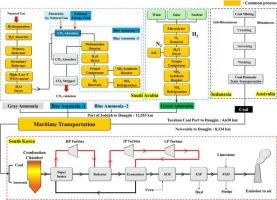推进传统电力系统:氨基脱碳的生命周期评估
IF 10.9
1区 工程技术
Q1 ENERGY & FUELS
引用次数: 0
摘要
向清洁能源系统的过渡引发了对传统发电厂氨共燃的讨论。然而,由于氨的生产是能源和碳密集型的,因此需要对其在全球二氧化碳减排方面的潜力进行全面评估。本研究将过程模拟与生命周期评估(LCA)相结合,对某1000mwe大型电厂的氨共燃烧进行了评价。分析了五种氨生产途径(灰色,蓝色,风能,太阳能,核能),三种煤类型(烟煤,亚烟煤,褐煤),共燃比从0到50%。在所有方案中,核基氨与褐煤共燃产生的全球变暖潜能值(GWP)减少量最大,每年可达1,258,919吨二氧化碳。在低碳合成氨生产和碳捕集与封存(CCS)一体化的未来技术应用场景下,CO2强度从762 g CO2/kWh下降到246 g CO2/kWh。相比之下,使用以化石燃料为基础的电网生产的蓝氨的情景导致氮氧化物排放量明显增加,强调了上游能源的影响。这些结果突出了氨生产方法和国家电力混合在决定整体环境绩效方面的关键作用。这项研究的结果可以为燃料进口政策、低碳技术选择和过渡能源战略提供信息,特别是对于那些旨在减少燃煤电厂排放同时利用现有基础设施的国家。本文章由计算机程序翻译,如有差异,请以英文原文为准。

Advancing conventional power systems: Life cycle assessment of ammonia-based decarbonization
The transition to clean energy systems has prompted discussion on ammonia co-combustion in conventional power plants. However, because ammonia is both energy- and carbon-intensive to produce, its potential for global CO2 reduction requires comprehensive assessment. This study integrates process simulation and life cycle assessment (LCA) to evaluate ammonia co-combustion in a 1000 MWe large-scale power plant. Five ammonia production pathways (gray, blue, wind, solar, nuclear), three coal types (bituminous, sub-bituminous, lignite), and co-combustion ratios ranging from 0 to 50 % were analyzed. Among all scenarios, co-combusting nuclear-based ammonia with lignite yielded the greatest global warming potential (GWP) reduction up to 1,258,919 tons CO2 per year. Furthermore, under future technology application scenarios, including low-carbon ammonia production and carbon capture and storage (CCS) integration, the CO2 intensity decreased from 762 to 246 g CO2/kWh. In contrast, scenarios using blue ammonia produced with fossil fuel-based electricity grids resulted in noticeably higher NOx emissions, underscoring the influence of upstream energy sources. These results highlight the critical role of ammonia production methods and national electricity mixes in determining overall environmental performance. The findings of this study can inform fuel import policies, low-carbon technology selection, and transitional energy strategies, particularly for countries aiming to reduce emissions from coal-fired power plants while utilizing existing infrastructure.
求助全文
通过发布文献求助,成功后即可免费获取论文全文。
去求助
来源期刊

Energy Conversion and Management
工程技术-力学
CiteScore
19.00
自引率
11.50%
发文量
1304
审稿时长
17 days
期刊介绍:
The journal Energy Conversion and Management provides a forum for publishing original contributions and comprehensive technical review articles of interdisciplinary and original research on all important energy topics.
The topics considered include energy generation, utilization, conversion, storage, transmission, conservation, management and sustainability. These topics typically involve various types of energy such as mechanical, thermal, nuclear, chemical, electromagnetic, magnetic and electric. These energy types cover all known energy resources, including renewable resources (e.g., solar, bio, hydro, wind, geothermal and ocean energy), fossil fuels and nuclear resources.
 求助内容:
求助内容: 应助结果提醒方式:
应助结果提醒方式:


